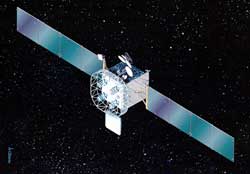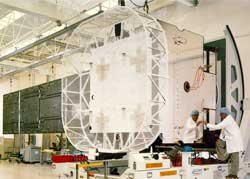UHF Follow-On: Evolving, advanced military communications
HUGHES SPACE AND COMMUNICATIONS FACT SHEET
Posted: Nov. 21, 1999
 Artist's impression of the UHF Follow-On satellite in orbit. Photo: Hughes Space and Communications |
In July 1988, Hughes Space and Communications Company won the competition for a fixed-price contract awarded by the Program Executive Office for Space, Communications, and Sensors in Washington, D.C. The initial agreement called for Hughes to build and launch one satellite, with options for nine more. Options for spacecraft 2 and 3 were exercised in May 1990; for 4, 5, and 6 in November 1990; and for 7, 8, and 9 in November 1991. In January 1994, the customer extended the contract by ordering a 10th satellite and launch services, bringing the total value to $1.7 billion.
In March 1996, for an additional $150 million, the Navy ordered a high-power, high-speed Global Broadcast Service (GBS) payload to be incorporated onto the last three satellites. This Phase II GBS package will revolutionize communications for the full range of the Defense Department's high-capacity requirements, from intelligence dissemination to quality-of-life programming. The first GBS payload was put into service in 1998. Full, three-satellite operational capability is planned for mid-1999.
The UHF F/O spacecraft has proven to be a very flexible platform for the efficient evolution of critical, advanced DOD communications services. The satellites are versions of the Hughes body-stabilized, three-axis HS 601 model. The spacecraft was introduced in 1987 to meet anticipated requirements for high-power, multiple-payload satellites for such applications as UHF F/O, direct television broadcasting to very small terminals, private business networks, and mobile communications.
The HS 601 body is composed of two main modules. The bus module houses the bus electronics, propulsion subsystem, and battery packs. The payload module contains the communications equipment and antennas. The UHF Follow-On contract calls for a minimum 10-year mission.
The UHF Follow-On satellites replace the Fleet Satellite Communications (FLTSATCOM) and the Hughes-built Leasat spacecraft currently supporting the Navy's global communications network, serving ships at sea and a variety of other U.S. military fixed and mobile terminals. They are compatible with ground- and sea-based terminals already in service.
 A technician at Hughes Space and Communications Company performs deployment testing of a solar wing for the UHF Follow-On F-10 spacecraft. Photo: Hughes Space and Communications |
The UHF F/O satellites offer increased communications channel capacity over the same frequency spectrum used by previous systems. Each spacecraft has 11 solid-state UHF amplifiers and 39 UHF channels with a total 555 kHz bandwidth. The UHF payload comprises 21 narrowband channels at 5 kHz each and 17 relay channels at 25 kHz. In comparison, FLTSATCOM offers 22 channels. The F-1 through F-7 spacecraft include an SHF subsystem, which provides command and ranging capabilities when the satellite is on station as well as the secure uplink for Fleet Broadcast service, which is downlinked at UHF.
The Navy has added an extremely high frequency communications package beginning with the fourth spacecraft. This addition includes 11 EHF channels distributed between an earth coverage beam and a steerable 5-degree spot beam and is compatible with Milstar ground terminals. The EHF subsystem provides enhanced antijam telemetry, command, broadcast, and fleet interconnectivity communications, using advanced signal processing techniques. The EHF Fleet Broadcast capability supersedes the need for the SHF fleet uplink. Beginning with UHF F/O F-7, the EHF package has been enhanced to provide 20 channels through the use of advanced digital integrated circuit technology.
The GBS payload replaces the SHF payload on spacecraft F-8, 9, and 10. This new package includes four 130-watt, 24 megabits-per-second (Mbps) military Ka-band (30/20 GHz) transponders with three steerable downlink spot beam antennas (two at 500 nmi and one at 2000 nmi) as well as one steerable and one fixed uplink antenna. This modification results in a 96 Mbps capability per satellite. Three spacecraft give the DOD near-global coverage. The system will transmit to small, mobile, tactical terminals.
The first seven satellites measure more than 60 feet long from the tip of one three-panel solar array wing to the tip of the other. Spacecraft F-8 through F-10 each have four solar panels on a side, making them 86 feet long. These arrays generate a combined 2500 watts of electrical power on the first three satellites, 2800 watts for F-4 through F-7, and 3800 watts for F-8 through F-10 with GBS.
| Previous launches | ||
| UHF F-1 | Mar. 25, 1993 * | |
| UHF F-2 | Sept. 3, 1993 | |
| UHF F-3 | June 24, 1994 | |
| UHF F-4 | Jan. 28, 1995 | |
| UHF F-5 | May 31, 1995 | |
| UHF F-6 | Oct. 22, 1995 | |
| UHF F-7 | July 25, 1996 | |
| UHF F-8 | Mar. 16, 1998 | |
| UHF F-9 | Oct. 20, 1998 | |
| * Did not reach intended orbit because of Atlas 1 first stage malfunction. Source: Spaceflight Now research |
||
Integrating the GBS payload requires several spacecraft modifications. The Ka-band traveling-wave tube amplifiers are integrated onto a larger south radiator panel with heat pipes added to accommodate the increased thermal dissipation. The GBS fixed receive antenna, together with the forward omni antenna, is mounted on the structure previously used for the SHF antennas. The GBS steerable receive antenna is mounted on a deployable boom. A new pallet structure has been added to integrate the three GBS transmit spot beam antennas. The nickel-hydrogen battery, which supports eclipse operations, has been enlarged to 164 from 126 amp-hour cells.
Hughes has chosen the Atlas rocket series to provide the launches from Cape Canaveral, Fla. The Atlas I rocket was used for the UHF-only satellites. The Atlas II was chosen for those with the additional EHF payloads and for those with GBS packages.
Vehicle: Atlas 2A AC-136
Payload: UHF F/O F-10
Launch date: Nov. 23, 1999
Launch window: 0406-0606 GMT (2306 EST on Nov. 22)
Launch site: Pad 36B, Cape Canaveral Air Station, Florida
Liftoff weight: 189,000 kg (417,770 lbs)
Video vault
PLAY (493k QuickTime file)
PLAY (RealVideo)
PLAY (274k QuickTime file)
PLAY (RealVideo)
PLAY (950k QuickTime file)
PLAY (RealVideo)
Download QuickTime 4 software or the Real Player to view these files.
NewsAlert
Sign up for Astronomy Now's NewsAlert service and have the latest news in astronomy and space e-mailed directly to your desktop (free of charge).
Explore the Net
International Launch Services - Lockheed Martin-led consortium which globally markets the U.S. Atlas and Russian Proton rockets.
Lockheed Martin Astronautics - U.S. company which builds and launches the Atlas family of rockets.
Hughes Space and Communications - A leading satellite manufacturer in the U.S.; built UHF F10.
Space & Naval Warfare Systems Command - U.S. government office responsible for UHF satellite program.
45th Space Wing - Division of the U.S. Air Force Space Command that runs the Eastern Range at Cape Canaveral.
ATLAS INDEX
HOME | TRACKING STATION | STORE | ASTRONOMY NOW
© 1999 Pole Star Publications Ltd
